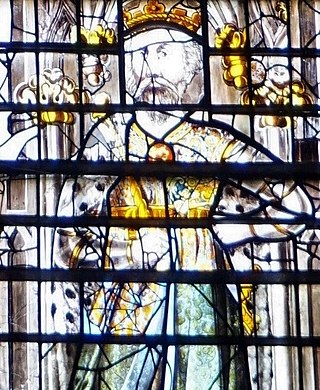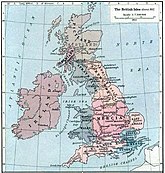
Bretwalda is an Old English word. The first record comes from the late 9th-century Anglo-Saxon Chronicle. It is given to some of the rulers of Anglo-Saxon kingdoms from the 5th century onwards who had achieved overlordship of some or all of the other Anglo-Saxon kingdoms. It is unclear whether the word dates back to the 5th century and was used by the kings themselves or whether it is a later, 9th-century, invention. The term bretwalda also appears in a 10th-century charter of Æthelstan. The literal meaning of the word is disputed and may translate to either 'wide-ruler' or 'Britain-ruler'.

Ceawlin was a King of Wessex. He may have been the son of Cynric of Wessex and the grandson of Cerdic of Wessex, whom the Anglo-Saxon Chronicle represents as the leader of the first group of Saxons to come to the land which later became Wessex. Ceawlin was active during the last years of the Anglo-Saxon expansion, with little of southern England remaining in the control of the native Britons by the time of his death.

The Kingdom of the West Saxons, also known as the Kingdom of Wessex, was an Anglo-Saxon kingdom in the south of Great Britain, from around 519 until England was unified in 927.

Æthelred I was King of Wessex from 865 until his death in 871. He was the fourth of five sons of King Æthelwulf of Wessex, four of whom in turn became king. Æthelred succeeded his elder brother Æthelberht and was followed by his youngest brother, Alfred the Great. Æthelred had two sons, Æthelhelm and Æthelwold, who were passed over for the kingship on their father's death because they were still infants. Alfred was succeeded by his son, Edward the Elder, and Æthelwold unsuccessfully disputed the throne with him.

Ecgberht, also spelled Egbert, Ecgbert, Ecgbriht, Ecgbeorht, and Ecbert, was King of Wessex from 802 until his death in 839. His father was King Ealhmund of Kent. In the 780s, Ecgberht was forced into exile to Charlemagne's court in the Frankish Empire by the kings Offa of Mercia and Beorhtric of Wessex, but on Beorhtric's death in 802, Ecgberht returned and took the throne.
Cynric was King of Wessex from 534 to 560. Everything known about him comes from the Anglo-Saxon Chronicle. There, he is stated to have been the son of Cerdic, who is considered the founder of the kingdom of Wessex. However, the Anglian King-list and parts of the West Saxon Genealogical Regnal List, instead says that Cynric was the son of Cerdic's son Creoda. Similarly, the paternal genealogy of Alfred the Great given in Asser's The Life of King Alfred, includes the name Creoda, while the account of the king's maternal ancestry in the same work calls Cynric son of Cerdic.

Cerdic is described in the Anglo-Saxon Chronicle as a leader of the Anglo-Saxon settlement of Britain, being the founder and first king of Wessex, reigning from around 519 to 534 AD. Subsequent kings of Wessex were each claimed by the Chronicle to descend in some manner from Cerdic. His origin, ethnicity, and even his very existence have been extensively disputed. However, though claimed as the founder of Wessex by later West Saxon kings, he would have been known to contemporaries as king of the Gewissae, a folk or tribal group. The first king of the Gewissae to call himself 'King of the West Saxons', was Cædwalla, in a charter of 686.

Ine, also rendered Ini or Ina, was King of Wessex from 689 to 726. At Ine's accession, his kingdom dominated much of southern England. However, he was unable to retain the territorial gains of his predecessor, Cædwalla, who had expanded West Saxon territory substantially. By the end of Ine's reign, the kingdoms of Kent, Sussex, and Essex were no longer under West Saxon sway; however, Ine maintained control of what is now Hampshire, and consolidated and extended Wessex's territory in the western peninsula.

Creoda may have been one of the first kings of the Anglo-Saxon kingdom of Mercia, ruling toward the end of the 6th century.

Cædwalla was the King of Wessex from approximately 685 until he abdicated in 688. His name is derived from the Welsh Cadwallon. He was exiled from Wessex as a youth and during this period gathered forces and attacked the South Saxons, killing their king, Æthelwealh, in what is now Sussex. Cædwalla was unable to hold the South Saxon territory, however, and was driven out by Æthelwealh's ealdormen. In either 685 or 686, he became King of Wessex. He may have been involved in suppressing rival dynasties at this time, as an early source records that Wessex was ruled by underkings until Cædwalla.

Anna was king of East Anglia from the early 640s until his death. He was a member of the Wuffingas family, the ruling dynasty of the East Angles, and one of the three sons of Eni who ruled the kingdom of East Anglia, succeeding some time after Ecgric was killed in battle by Penda of Mercia. Anna was praised by Bede for his devotion to Christianity and was renowned for the saintliness of his family: his son Jurmin and all his daughters – Seaxburh, Æthelthryth, Æthelburh and possibly a fourth, Wihtburh – were canonised.

Cynegils was King of Wessex from c. 611 to c. 642. Cynegils is traditionally considered to have been King of Wessex, even though the kingdoms of the Heptarchy had not yet formed from the patchwork of smaller kingdoms in his lifetime. The later kingdom of Wessex was centred on the counties of Hampshire, Dorset, Somerset and Wiltshire but the evidence of the Anglo-Saxon Chronicle is that the kingdom of Cynegils was located on the upper River Thames, extending into northern Wiltshire and Somerset, southern Gloucestershire and Oxfordshire, and western Berkshire, with Dorchester-on-Thames as one of the major royal sites. This region, probably connected to the early tribal grouping known as the Gewisse, a term used by Bede for the West Saxons, lay on the frontier between the later kingdoms of Wessex and Mercia.
Ceolwulf was a king of Wessex. At that early date the West Saxons were called the Gewisse, and in his Dictionary of National Biography entry he is given the title "king of the Gewisse". According to the Anglo-Saxon Chronicle he reigned fourteen years and the Annals of St Neots also allot him fourteen years. The West Saxon Genealogical Regnal List gives him a reign of seventeen years.
Ceol is portrayed by the Anglo-Saxon Chronicle and West Saxon Genealogical Regnal List as King of Wessex for five to six years around 592 to 597 or 588 to 594.
Alberht was an eighth-century ruler of the kingdom of East Anglia. He shared the kingdom with Beonna and possibly Hun, who may not have existed. He may still have been king in around 760. He is recorded by the Fitzwilliam Museum and the historian Simon Keynes as Æthelberht I.
Creoda is a shadowy figure from early Wessex history whose existence is disputed.

The Anglian collection is a collection of Anglo-Saxon royal genealogies and regnal lists. These survive in four manuscripts; two of which now reside in the British Library. The remaining two belong to the libraries of Corpus Christi College, Cambridge and Rochester Cathedral, the latter now deposited with the Medway Archives.
A number of royal genealogies of the Anglo-Saxon kingdoms, collectively referred to as the Anglo-Saxon royal genealogies, have been preserved in a manuscript tradition based in the 8th to 10th centuries.

The West Saxon Genealogical Regnal List is the name given in modern scholarship to a list of West-Saxon kings. It is one of the main sources for understanding the early history of Wessex and the attempts of its dynasties to project an image of dynastic stability.














